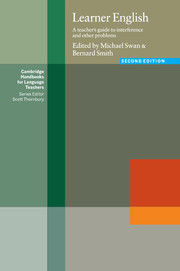Book contents
- Frontmatter
- Contents
- Notes on contributors
- Introduction
- Note for teachers of American English
- List of phonetic symbols
- Acknowledgements
- Dutch speakers
- Speakers of Scandinavian languages
- German speakers
- French speakers
- Italian speakers
- Speakers of Spanish and Catalan
- Portuguese speakers
- Greek speakers
- Russian speakers
- Polish speakers
- Farsi speakers
- Arabic speakers
- Turkish speakers
- Speakers of South Asian languages
- Speakers of Dravidian languages
- Speakers of West African languages
- Swahili speakers
- Malay/Indonesian speakers
- Japanese speakers
- Chinese speakers
- Korean speakers
- Thai speakers
- The cassette and CD
Italian speakers
- Frontmatter
- Contents
- Notes on contributors
- Introduction
- Note for teachers of American English
- List of phonetic symbols
- Acknowledgements
- Dutch speakers
- Speakers of Scandinavian languages
- German speakers
- French speakers
- Italian speakers
- Speakers of Spanish and Catalan
- Portuguese speakers
- Greek speakers
- Russian speakers
- Polish speakers
- Farsi speakers
- Arabic speakers
- Turkish speakers
- Speakers of South Asian languages
- Speakers of Dravidian languages
- Speakers of West African languages
- Swahili speakers
- Malay/Indonesian speakers
- Japanese speakers
- Chinese speakers
- Korean speakers
- Thai speakers
- The cassette and CD
Summary
Distribution
ITALY, REPUBLIC OF SAN MARINO, VATICAN, SWITZERLAND, Malta, Somalia.
Introduction
Italian is an Indo-European language, directly descended from Latin and closely related to Spanish, Portuguese and French. There is a wide variety of regional dialects, many of which are mutually unintelligible, and some of which have a literary tradition of their own.
Most Italians are very conscious of their regional origins, and are quick to point out that they are Neapolitan, or Tuscan, or Sardinian, as well as Italian. Especially in the industrialised north, most educated Italians use the standard language, which evolved from a variety of Tuscan; but many can adopt the local dialect, and do so when speaking to dialect users, or in particular situations. In rural areas and in the south, dialect may be the first language for many.
Italian language is a compulsory subject throughout primary and secondary school, and this is likely to have an effect on the way English will be learned. Italian speakers have some assistance in learning English through their awareness of the Latin origins of much English lexis and syntax. The Anglo-Saxon elements in English, however, can cause difficulties, and basic and colloquial English usage often causes more trouble than more formal or academic registers.
Italian learners are often very worried about grammatical accuracy; this may reflect the insistence on ‘correct Italian’ that is common in mother-tongue teaching. They usually have a high level of grammatical awareness, which can be exploited in foreign language learning situations.
- Type
- Chapter
- Information
- Learner EnglishA Teacher's Guide to Interference and Other Problems, pp. 73 - 89Publisher: Cambridge University PressPrint publication year: 2001
- 3
- Cited by

